Lebanese property market slowing amidst political uncertainty
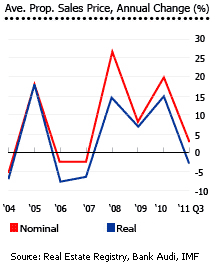
After several years of strong activity, the property market in Lebanon is declining sharply, mainly due to domestic political bickering and regional unrest.
In the year to end-Q3 2011, the average property sales price in the country rose by 4% from a year earlier, according to Bank Audi’s Research Department. However, when adjusted for inflation, property prices actually dropped by about 2.7% over the same period. This was in sharp contrast with the strong house price rises that the Lebanese property market has experienced in the past three years.
- In 2008, average property sales prices soared by 26.8% y-o-y (14.5% in real terms)
- In 2009, average property prices rose by about 8.4% y-o-y (7.1% in real terms)
- In 2010, average property sales prices increased by 20.2% y-o-y (15.1% in real terms)

The average value per property sale was LBP157.6 million (US$104,000) in Q3 2011, based on figures released by Bank Audi.
Lebanese house prices are likely to remain at or near current levels, according to Bank Audi. In addition, real estate transactions are expected to fall further in 2012 due to the adverse impact of the ongoing domestic and regional political stalemate. Worse, a proposed hike in real estate sales tax, in an effort to raise government revenues in 2012, is expected to exacerbate the situation.
Economic growth slows sharply
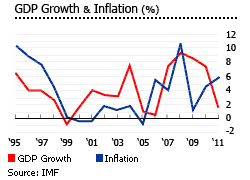
Economic growth has slowed sharply in Lebanon. GDP grew just 1.5% in 2011, the slowest growth since 2006, according to Banque du Liban. The Lebanese economy grew by an annual average of 8.2% from 2007 to 2010.
In 2012, the economy is expected to grow by a modest 3% to 4%, according to the IMF.
Consumer prices rose by about 6% in 2011, according to Banque du Liban. In 2012, the inflation rate is expected at 5%, according to the IMF.
In the year to Q3 2011, balance of payments (BOP) posted a deficit of LBP2.27 trillion (US$1.5 billion) compared to a surplus of LBP4.4 trillion (US$2.9 billion) in the same period last year. Lebanon accumulated surpluses of about LBP5.3 trillion (US$3.5 billion) in 2008, LBP11.97 trillion (US$7.9 billion) in 2009 and LBP5.05 trillion (US$3.33 billion) in 2010.
Tourism in the country is also losing appeal. The total number of tourists fell by 24.7% to 1,276,110 during the year to November 2011. It was in sharp contrast with the annual average growth of 28.7% during the boom period of 2007 to 2010.
Domestic political tensions brought down the government of Prime Minister Saad al-Hariri in January 2011. Saad al-Hariri was succeeded by Najib Mikati, whose government is now criticized for its inability to solve the country’s economic and social problems. The domestic political problems that the country is facing have been exacerbated by the ongoing regional turmoil named as the Arab Spring (also called Arab Awakening) which started last December 2010.
Land price variations
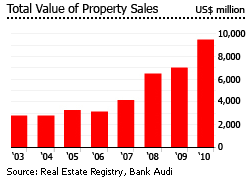
In Beirut’s prime areas, land prices currently ranged from LBP3 million (US$2,000) to LBP7.6 million (US$5,000) per square meter (sq. m.) of built-up area (BUA), according to Ramco Real Estate Advisers.
- The Central Business District (CBD) has the most expensive land in Beirut. Land prices ranged from LBP5.3 million (US$3,500) to LBP7.6 million (US$5,000) per sq. m.
- In Hamra, one of Beirut’s main economic and diplomatic hubs, land prices ranged between LBP2.73 million (US$1,800) and LBP3.33 million (US$2,200) per sq. m.
- In Furn el Hayek, which is in high demand from the local social elite, land prices vary from LBP2.73 million (US$1,800) and LBP3.03 million (US$2,000) per sq. m.
On the other hand, in underdeveloped peripheral areas, land prices vary between LBP1.2 million (US$800) and LBP2.3 million (US$1,500) per sq. m. of BUA.
- In Jnah, an underdeveloped area in the capital, land prices ranged between LBP1.8 million (US$1,200) to LBP2.3 million (US$1,500) per sq. m.
- In Comiche El Nahr, land prices ranged between LBP1.2 million (US$800) to LBP2.1 million (US$1,400) per sq. m.
Property sales falling
In the year to end-Q3 2011, the total number of property sales in Lebanon fell by 16.5% to 57,976 units from the same period last year, according to Bank Audi. The total number of property sales rose by 13% y-o-y in 2010 but dropped by 18% in 2009.
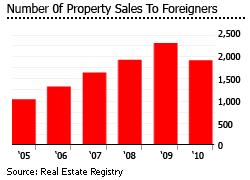
Likewise, the total value of property sales plunged by 13.4% to LBP9.14 trillion (US$6.03 billion) over the year to Q3 2011, according to data released by the Real Estate Registry. From 2005 to 2010, total property sales value increased by an average of 23.5% per year.
The regional political unrest is negatively affecting property investments by foreigners and other Arab nationals. As of May 2011, property sales to foreigners plunged by 32.1% from the same period of the previous year, according to the Real Estate Registry. In 2010, the number of property sales to foreigners dropped by 17% y-o-y, after an average annual growth of 22% from 2006 to 2009.
As of October 2011, foreign homebuyers represent just about 2.02% of sales transactions in Lebanon, down from 2.04% in 2010 and 2.53% in 2009.
Construction activity declining
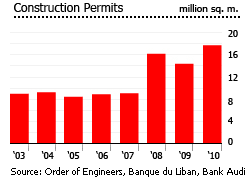
New construction permits, an indicator of construction activity and future supply, are now falling after having increased by an average of 16.4% annually from 2005 to 2010.
As of November 2011, newly issued construction permits were 6.2% down to 14.72 million sq. m. compared to the same period in the previous year, according to the Order of Engineers in Beirut and Tripoli.
However, cement deliveries, also a gauge of the state of the construction sector, increased 7.7% to 4.16 million tons during the year to end-Q3 2011.
Some of the major residential developments in Lebanon:
BeitMisk
BeitMisk is a huge $800 million residential community project in the mountainous Northern Metn region, covering more than 655,000 sq. m., and expected to house around 15,000 residents. Announced in mid-2009, BeitMisk offers apartment units, villas and penthouses to homebuyers. It also offers a country club, gardens, recreational areas, and retail stores.
Beirut
The Beirut Towers is a US$125 million luxury residential development in Beirut launched by Plus Properties, a Dubai-based developer. Still under construction, it consists of two 23-storey towers, named Verdun and Ashrafieh—two of the most prestigious residential neighborhoods in the city. The two towers offer studio, one and two-bedroom apartments on single or duplex floors.
Venus Towers
This US$500 million residential development was launched last September 2009 by Venus Real Estate Development Co. It stretches over 7,510 metres in Marina, Solidere in Beirut. The development is surrounded by 3,500 sq. m of gardens, jogging tracks and playgrounds.
Venus Towers has 3 luxurious residential buildings—Bloc A-30-storey; Bloc B-26-storey; and Bloc C-20-storey. Apartments range from 250 sq. m to 650 sq. m. Amenities include a swimming pool, gymnasium, guest parking spaces, a commercial area and a security.
Marina Towers
The Marina Towers, completed in 2007, is a residential complex near the Beirut Marina. The development consists of the Marina Tower, Marina Court, and Marina Garden. The Marina Tower is the highest among the three buildings, at 150-m height built on over 7,000 sq. m land. On the other hand, the Marina Garden, surrounded by over 3,000 sq. m gardens, and the Marina Court, offers relatively smaller apartment units.
Sama Beirut
Launched in August 2009 by Antonios Projects, Sama Beirut is a 50-storey mixed use project located in Ashrafieh, near downtown Beirut, set to be fully-operational by 2014.
Its 200-m skyscraper, set to become the tallest building in the country, will have residential, commercial and retail space. It offers residential apartments, with sizes ranging from 300 sq. m to 1,500 sq. m. In addition, the tower will also feature six commercial shops and office spaces.
Platinum Towers
Platinum Towers, at 153-metres, is currently Lebanon’s tallest residential building. The US$200 million building, completed in 2008, is in the heart of Beirut’s dynamic central district, along the Beirut Marina. Platinum Towers is only a few minutes away from the Beirut International Airport.
Mortgage market expanding
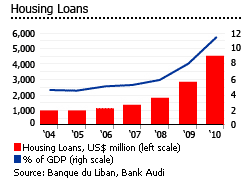
In Lebanon, buyers have traditionally paid cash, or benefited from pre-selling schemes. Homebuyers purchase an apartment unit during the construction phase, put a down payment and make monthly installments until the project is completed.
Housing loans have traditionally only been available to the developers of new properties. Yet today, several banks have begun offering mortgage loans directly to homebuyers. The Lebanese mortgage market grew to 11.5% of GDP in 2010, from an average of 4.9% from 2004 to 2007.
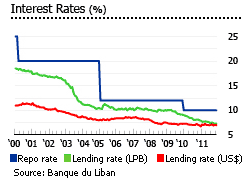
Outstanding housing loans soared 61% to LBP6.83 trillion (US$4.51 billion) in 2010 from a year earlier, according to the Banque du Liban. Then in March 2011, total outstanding housing loans rose again by 7% q-o-q to LBP7.27 trillion (US$4.8 billion).
The repo rate is currently at 10%, unchanged since December 2009.
Interest rates for housing loans are usually tied to the US prime rate or LIBOR, with a fixed percentage added. The loan-to-value (LTV) ratio ranges from 50% to 85% of the appraised value or actual purchase price of the property, whichever is lower. The term period is usually from 20 to 30 years. Lebanese banks require both life and house insurance from loan applicants.
The biggest risk - falling rental yields
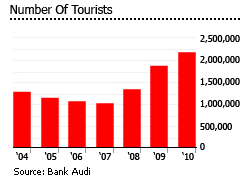
Gross rental yields in Beirut have again dropped in 2011. Gross rental yields on Beirut apartments now range from 2.7% to 3.5%, very significantly down from an average of 10% to 11% six years ago.
In October 2011, the average monthly rents in Beirut ranged from LBP2.84 million (US$1,872) for 150 sq. m. apartments, to LBP8.74 million (US$5,769) for 450 sq. m. apartments, according to the Global Property Guide’s research.
Average rents for the market as a whole are lowered by the survival of many pre-1992 contracts, creating a class of sitting tenants paying low rents, who cannot be evicted except at great cost (see Lebanon’s Landlord and Tenant Law). However this law does not affect post-1992 contracts, which are equally balanced between landlord and tenant. (The Global Property Guide’s research only covers current offers for sale and offers to rent, not pre-existing contracts).
In Beirut, the average occupancy rate is about 60%, according to Ramco Real Estate Advisers.